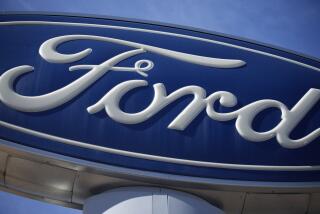Ford plans to hitch a ride with GM
With the U.S. auto industry melting down, General Motors Corp. executives are burning up phone lines to Washington seeking billions in financial aid to help cement a merger with Chrysler. Ford Motor Co., meanwhile, has developed an intriguing strategy: Sit back and watch.
Crashing sales, mounting losses and frozen credit markets have forced all three major U.S. automakers to raid their cash stockpiles. GM hopes that a tie-up with Chrysler will help it cut costs. But GM’s first choice was Ford, which it approached before Chrysler about a deal only to be rebuffed, according to individuals familiar with the company who were not authorized to speak publicly about the talks.
Instead, Ford’s plan, these insiders say, is to let GM and others do the heavy lifting, exploring options for help from the federal government and, potentially, hammering out new cost reductions from the United Auto Workers union.
So even as governors from six states sent a letter Thursday to the Treasury Department and the Federal Reserve urging “immediate action” in resolving the automakers’ woes, Ford brass were at the company’s F-150 pickup plant in Dearborn, Mich., announcing the hiring of 1,000 workers and the addition of another shift on the line.
“Whatever happens in the industry, there should be parity,” Ford Executive Vice President Mark Fields said. “We fully support all the things that the Federal Reserve and Treasury are doing to stabilize the market and provide liquidity.”
“Parity” is something of a buzzword. The idea is that any help GM gets from Washington -- be it via guaranteed loans, direct equity investments or access to the Treasury’s $700-billion distressed asset purchase plan -- should apply to Ford as well.
Ditto for concessions from the UAW, which is said to be under pressure from GM to allow the carmaker to postpone billions in payments into a trust created last year to manage retiree benefits.
“If they’re going to give money or other benefits to GM, there’s no way that Ford won’t be asking for those, too,” said Aaron Bragman, auto industry analyst at IHS Global Insight. “Their argument is that if one company gets access to low-interest loans, so should we.”
For Ford, such a strategy could make a lot of sense. Thanks to $23 billion in loans it took out two years ago, the nation’s second-largest automaker has a stronger cash position than GM, and most analysts expect it to survive 2009 at current spending rates.
“We estimate Ford has nine to 12 quarters of liquidity,” Shelly Lombard, a debt analyst at Gimme Credit, said this month. Meanwhile, analysts are predicting that GM could run out of money next year.
That makes it harder for Ford to plead poverty in Washington. And with a smaller market share and fewer jobs at stake -- Ford employs fewer than 70,000 in the U.S. compared with 104,000 at GM -- Henry Ford’s company may not pull the same weight when it comes to begging favors.
But when it comes to sharing in the bounty, Ford would be following a familiar path. Last year, when GM, Chrysler and Ford were negotiating new contracts with the UAW, the companies applied “pattern bargaining,” which essentially binds all similar parties to a deal to the same terms. GM, the biggest of the three, took the lead in negotiations. Once its contract was inked, the other companies followed suit.
That contract offered the potential for huge savings by reducing wages for some workers and removing billions in healthcare liabilities from the automakers’ books. To do that, the companies agreed to pay a combined $43 billion into a trust called a Voluntary Employee Beneficiary Assn.
Now some analysts believe that a GM-Chrysler merger would necessitate a renegotiation of that contract, as well as the VEBA payments. And, the logic goes, any new deal hashed out by GM-Chrysler probably would apply to Ford.
“Given the situation that the companies are in, the union’s leverage is minimal,” said industry analyst Tom Libby at J.D. Power & Associates. “And I think Ford would expect to get as much as everybody else.”
A GM-Chrysler merger is likely to result in massive layoffs -- a report out Thursday by consultancy Grant Thornton predicted that 74,000 jobs would be lost and many Chrysler models would be discontinued. That would benefit Ford if some Chrysler customers choose Ford products instead of those from GM.
Still, hitching a free ride isn’t Ford’s only plan. The automaker is working to overhaul its lineup, bringing six fuel-efficient European models to the U.S. It’s exploring a sale of its 33% stake in Mazda Motor Co. And this week Ford’s lending arm, Ford Credit, was approved for the Fed’s new short-term lending facility (as were GMAC, GM’s lending arm, and Chrysler Financial).
Despite its better cash position relative to GM, Ford has problems.
The automaker lost $8.6 billion in the first two quarters and is expected to post a large third-quarter shortfall next week. Its U.S. sales have fallen 17% through September compared with last year, and recent product introductions have been disappointing.
Meanwhile, Ford’s stock has been swooning, dropping below $2 this month for the first time since 1982. That prompted billionaire investor Kirk Kerkorian, who bought a 6.4% stake in the company this spring, to sell off much of his holdings, a move that came only days after two board members quit the company and Ford’s chief financial officer abruptly retired.
Ford’s Fields insists that the company’s best option is to stick to its plan.
“The rest of this year and 2009 are looking to be pretty challenging,” he said. “But we need to not get distracted by events that are unfolding in the industry.”
--






